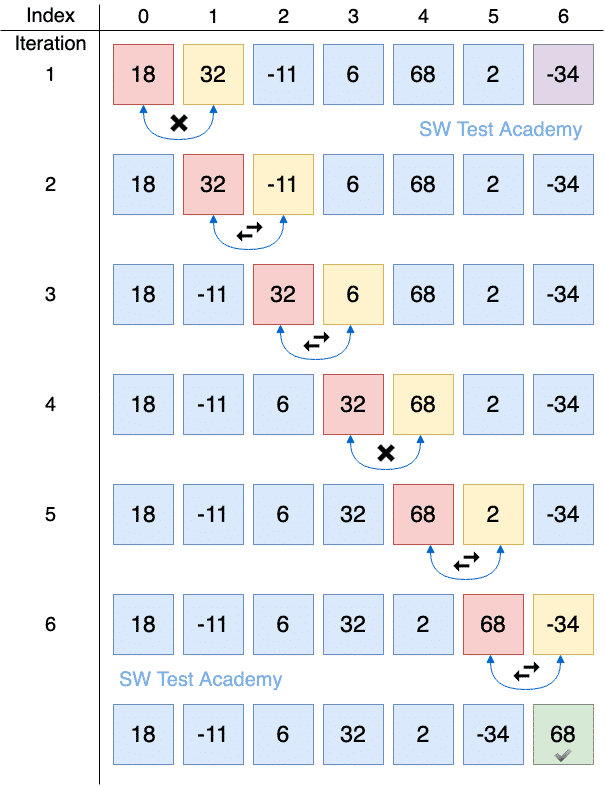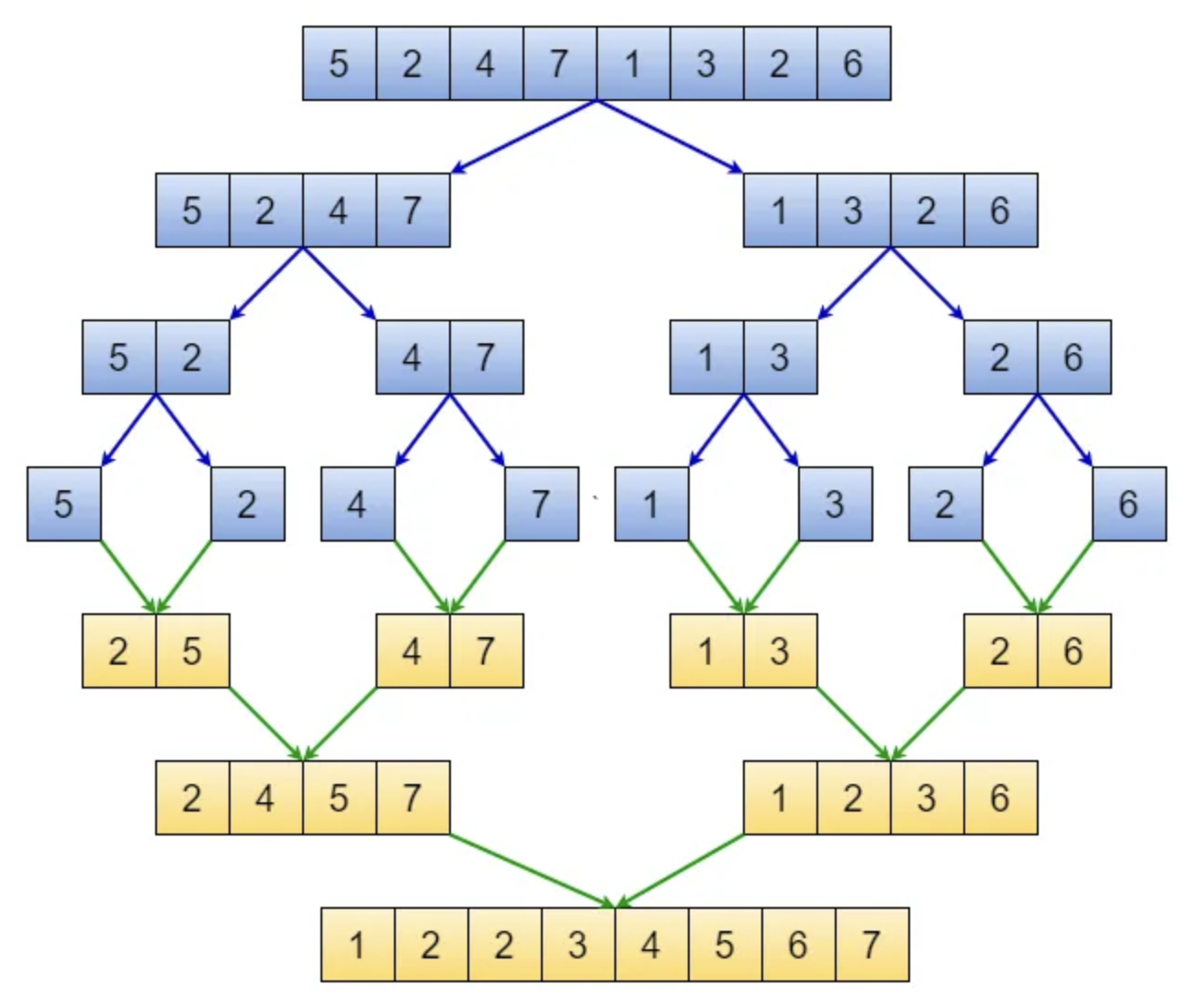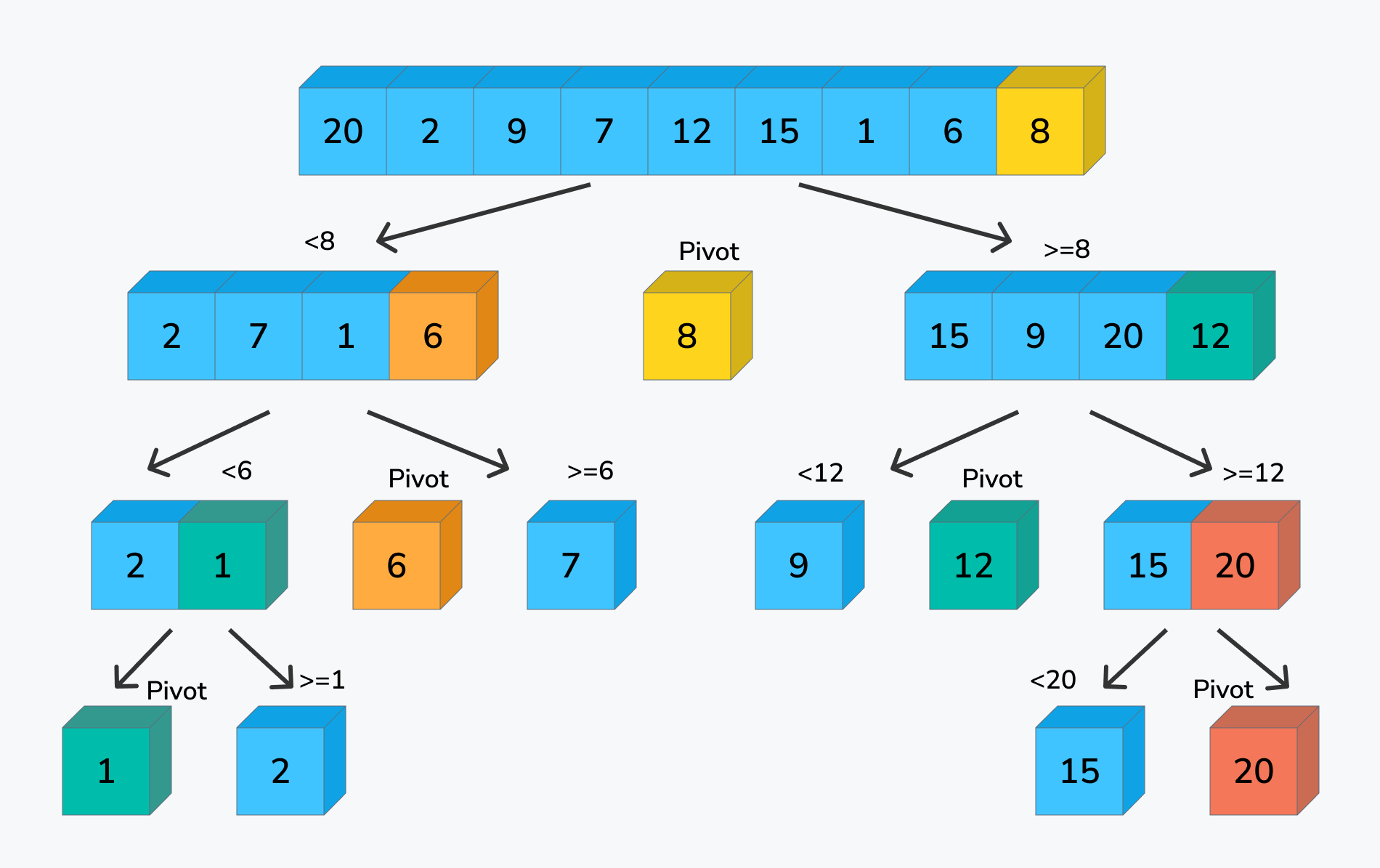sorting
Sorting is the act of rearranging elements in a sequence in order, either in numerical or lexicographical order, and either ascending or descending
| 2 | 7 | 4 | 1 | 5 | 3 | Unsorted array
| 1 | 2 | 3 | 4 | 5 | 7 | Array sorted in increasing order
| 7 | 5 | 4 | 3 | 2 | 1 | Array sorted in decreasing order
Another example: sort string in lexicographical order
| "aaa" | "a" | "ab" | "bc" | "bcd" | "d" | Unsorted array
| "a" | "aaa" | "ab" | "bc" | "bcd" | "d" | Array sorted in increasing order
| "d" | "bcd" | "bc" | "ab" | "aaa" | "a" | Array sorted in decreasing order
There are a lot sorting algorithms
- Bubble sort
- Insertion sort
- Selection sort
- Quicksort
- Mergesort
- Heapsort
- Counting sort
- Radix sort
But you don't need to remember the details in interview. Because most programming languages should already provide the "sort" function
Bubble Sort
Algorithm
- Traverse from left and compare adjacent elements and the higher one is placed at right side
- In this way, the largest element is moved to the rightmost end at first
- This process is then continued to find the second largest and place it and so on until the data is sorted
Complexity
- Time: O(n²)
- Space: O(1)

def bubble_sort(arr):
n = len(arr)
for i in range(n-1):
for j in range(n-i-1):
if arr[j] > arr[j + 1]:
tmp = arr[j]
arr[j] = arr[j+1]
arr[j+1] = tmp
Merge Sort
Algorithm
- Divide the array into two halves
- Sort each half
- Then merge the sorted halves back together
- This process is repeated until the entire array is sorted
Complexity
- Time: O(nlogn)
- For example
n=8→ we need 3 divisions →2^3 = 8→log2(8) = 3n=16→log2(16) = 4→ 4 divisions
- For example
- Space complexity: O(n)
Merge phase in details
- We has 2 pointers for the 2 arrays
- We compare the 2 elements
- We put the smaller element into the result and increment the pointer

def merge(left_half, right_half, arr):
i = j = k = 0
while i < len(left_half) and j < len(right_half):
if left_half[i] < right_half[j]:
arr[k] = left_half[i]
i +=1
else:
arr[k] = right_half[j]
j += 1
k += 1
while i < len(left_half):
arr[k] = left_half[i]
i += 1
k += 1
while j < len(right_half):
arr[k] = right_half[j]
j += 1
k += 1
def merge_sort(arr):
if len(arr) > 1:
mid = len(arr) // 2
left_half = arr[:mid]
right_half = arr[mid:]
merge_sort(left_half)
merge_sort(right_half)
merge(left_half, right_half, arr)
//in an integer division operator, which means it always rounds down to the nearest integer5 // 2 = 2→left_half: 0-2andright_half: 2-5- With odd arrays, the right sub-array will have 1 more element than the left sub-array
6 // 2 = 3→left_half: 0-3andright_half: 3-6- With even arrays, the two sub-arrays have equal length
Quick Sort
Algorithm
- An array is divided into subarrays by selecting a pivot element (element selected from the array)
- Position the pivot in a such a way that:
- Elements less than pivot are kept on the left side of the pivot
- Elements greater than pivot are on the right side of the pivot
- The left and right subarrays are also divided using the same approach. This process continues until each subarray contains a single element
- At this point, elements are already sorted. Finally, elements are combined to form a sorted array
Complexity
- Time
- Best case and average case: O(nlogn)
- Worst case: O(n²)
- Space
- Best case and average case: O(logn)
- Worst case: O(n)
Partition phase with pivot in details
- Keep a pointer pointing to the pivot element
- Keep another pointer "i" keep track of the smaller elements of pivot
- Iterate from left to right
- If we encounter element < pivot value, swap the current element with the one in index "i" Then increment "i"
- Finally, we swap the pivot element with the element in index "i"
def partition(arr, left, right):
pivot = arr[right]
i = left
for j in range(left, right):
if arr[j] < pivot:
arr[i], arr[j] = arr[j], arr[i]
i += 1
arr[i], arr[right] = arr[right], arr[i]
return i
def quick_sort(arr, left, right):
if left < right:
pI = partition(arr, left, right)
quick_sort(arr, left, pI - 1)
quick_sort(arr, pI + 1, right)

Sorting Functions
- C++:std::sort()
- Python: sort()
- Java
- Arrays.sort() and Arrays.sort() with comparator
- Collections.sort() and Collections.sort() with comparator
- Note: In interview, just say that all sort functions has O(nlogn) time complexity